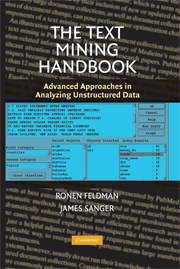Book contents
- Frontmatter
- Contents
- Preface
- I Introduction to Text Mining
- II Core Text Mining Operations
- III Text Mining Preprocessing Techniques
- IV Categorization
- V Clustering
- VI Information Extraction
- VII Probabilistic Models for Information Extraction
- VIII Preprocessing Applications Using Probabilistic and Hybrid Approaches
- IX Presentation-Layer Considerations for Browsing and Query Refinement
- X Visualization Approaches
- XI Link Analysis
- XII Text Mining Applications
- Appendix A DIAL: A Dedicated Information Extraction Language for Text Mining
- Bibliography
- Index
VII - Probabilistic Models for Information Extraction
Published online by Cambridge University Press: 08 August 2009
- Frontmatter
- Contents
- Preface
- I Introduction to Text Mining
- II Core Text Mining Operations
- III Text Mining Preprocessing Techniques
- IV Categorization
- V Clustering
- VI Information Extraction
- VII Probabilistic Models for Information Extraction
- VIII Preprocessing Applications Using Probabilistic and Hybrid Approaches
- IX Presentation-Layer Considerations for Browsing and Query Refinement
- X Visualization Approaches
- XI Link Analysis
- XII Text Mining Applications
- Appendix A DIAL: A Dedicated Information Extraction Language for Text Mining
- Bibliography
- Index
Summary
Several common themes frequently recur in many tasks related to processing and analyzing complex phenomena, including natural language texts. Among these themes are classification schemes, clustering, probabilistic models, and rule-based systems.
This section describes some of these techniques generally, and the next section applies them to the tasks described in Chapter VI.
Research has demonstrated that it is extremely fruitful to model the behavior of complex systems as some form of a random process. Probabilistic models often show better accuracy and robustness against the noise than categorical models. The ultimate reason for this is not quite clear and is an excellent subject for a philosophical debate.
Nevertheless, several probabilistic models have turned out to be especially useful for the different tasks in extracting meaning from natural language texts. Most prominent among these probabilistic approaches are hidden Markov models (HMMs), stochastic context-free grammars (SCFG), and maximal entropy (ME).
HIDDEN MARKOV MODELS
An HMM is a finite-state automaton with stochastic state transitions and symbol emissions (Rabiner 1990). The automaton models a probabilistic generative process. In this process, a sequence of symbols is produced by starting in an initial state, emitting a symbol selected by the state, making a transition to a new state, emitting a symbol selected by the state, and repeating this transition–emission cycle until a designated final state is reached.
- Type
- Chapter
- Information
- The Text Mining HandbookAdvanced Approaches in Analyzing Unstructured Data, pp. 131 - 145Publisher: Cambridge University PressPrint publication year: 2006



